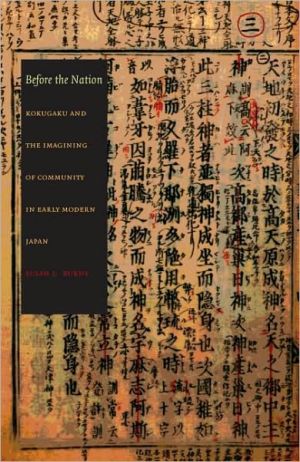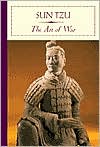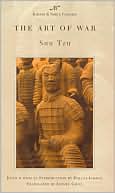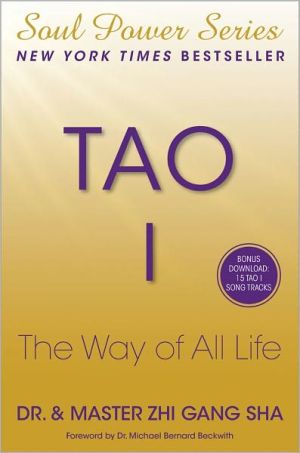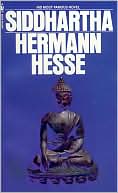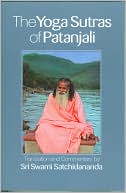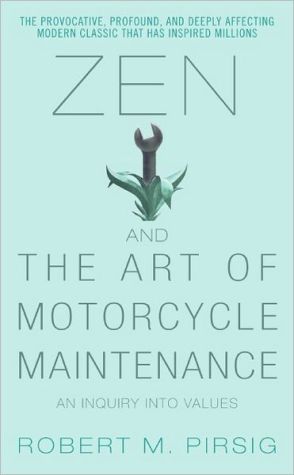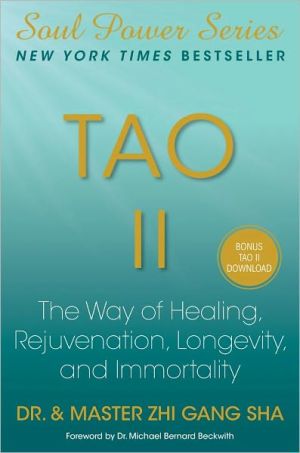Before the Nation: Kokugaku and the Imagining of Community in Early Modern Japan
Exploring the emergence and evolution of theories of nationhood that continue to be evoked in present-day Japan, Susan L. Burns provides a close examination of the late-eighteenth-century intellectual movement kokugaku, which means "the study of our country.” Departing from earlier studies of kokugaku that focused on intellectuals whose work has been valorized by modern scholars, Burns seeks to recover the multiple ways "Japan" as social and cultural identity began to be imagined before...
Search in google:
Exploring the emergence and evolution of theories of nationhood that continue to be evoked in present-day Japan, Susan L. Burns provides a close examination of the late-eighteenth-century intellectual movement kokugaku, which means "the study of our country." Departing from earlier studies of kokugaku that focused on intellectuals whose work has been valorized by modern scholars, Burns seeks to recover the multiple ways "Japan" as social and cultural identity began to be imagined before modernity.Central to Burns's analysis is Motoori Norinaga's Kojikiden, arguably the most important intellectual work of Japan's early modern period. Burns situates the Kojikiden as one in a series of attempts to analyze and interpret the mythohistories dating from the early eighth century, the Kojiki and Nihon shoki. Norinaga saw these texts as keys to an original, authentic, and idyllic Japan that existed before being tainted by "flawed" foreign influences, notably Confucianism and Buddhism. Hailed in the nineteenth century as the begetter of a new national consciousness, Norinaga's Kojikiden was later condemned by some as a source of Japan's twentieth-century descent into militarism, war, and defeat. Burns looks in depth at three kokugaku writers-Ueda Akinari, Fujitani Mitsue, and Tachibana Moribe-who contested Norinaga's interpretations and produced competing readings of the mythohistories that offered new theories of community as the basis for Japanese social and cultural identity. Though relegated to the footnotes by a later generation of scholars, these writers were quite influential in their day, and by recovering their arguments, Burns reveals kokugaku as a complex debate-involving history, language, and subjectivity-with repercussions extending well into the modern era.
Before the nation\ Kokugaku and the imagining of community in early modern Japan \ \ By Susan L. Burns \ Duke University Press\ \ ISBN: 0-8223-3172-1 \ \ \ Chapter One\ Late Tokugawa Society and the Crisis of Community \ Miroslav Hroch, the pioneer social historian of European nation-formation, has argued that "for national consciousness to arise, there must be something for it to become conscious of." His point is that historically the constitution of the nation as a new locus of identity has occurred in the context of a set of socioeconomic transformations that made it possible to begin to think beyond traditional conceptions of community. These transformations include a social or political crisis of the old order that brings rising-discontent among many within a society and a loss of faith in traditional moral systems, new forms of social and geographic mobility resulting from the commercialization of agriculture and handicraft production in the countryside, and a high level of social communication made possible by expanding rates of literacy, the formation of schools, and the rise of market relations. Within this kind of social setting, as traditional ties weakened or dissolved, new collective identities began to take form. Significantly, Hroch, while focusing on the social context that gives rise to nationalism, avoids the reductionism and determinism that have characterized some attempts to explain the rise of nationalism. The social changes he delineates arenot presented as the "causes" of nationalism, but rather as a set of conditions that contributed to its conceptualization.\ Hroch's work focused on European society, but his discussion provides a framework for reconsidering the developments that shaped Japanese society in the late Tokugawa period as the kokugaku discourse on Japan emerged. This was a tumultuous era, marked by economic change, natural disasters, famine, and unrest, but also by new forms of cultural production, spurred by expanding literacy, a burgeoning publication industry, and the creation and diffusion of popular media. It was in this context, as older explanations of how society "worked" became increasingly difficult to maintain, that Norinaga, Akinari, Mitsue, and Moribe began to rethink the political, social, and geographic divisions that ordered their world. The prolonged debate over the nature of Japan in which they engaged is the focus of the chapters that follow, but in this chapter I want to discuss the social conditions that mediated their attempts to explore community.\ THE READERS IN QUESTION\ The background of the kokugaku scholars themselves provides a window into the complexity of late Tokugawa Japan. While the founders of the Tokugawa political order had envisioned a society in which social and geographic mobility would be limited and in which the bushi or samurai as scholar-officials would be at the center of cultural productions, the experiences of Norinaga, Akinari, Mitsue, and Moribe suggest how inadequate this conception had become. They are a heterogeneous group, and the course of their lives defies easy generalization by means of reference to either social or spatial boundaries.\ Motoori Norinaga was born in 1730 in Matsuzaka, the second son of a wealthy cotton merchant, Ozu Sadatoshi. After his father's death in 1740, the family's finances suffered, but they were still affluent enough to provide Norinaga with a good education. He was schooled in Confucian texts like many merchant sons of his day and also received lessons in poetry composition, tea ceremony, and no chanting. At the age of sixteen Norinaga was sent to an uncle's shop in Edo as an apprentice, but he returned home after only one year after apparently showing no talent for business. He was then adopted into the Imaida family, paper merchants in Yamada, a town not far from Matsuzaka. However, life with his adopted family apparently did not go smoothly, and he again returned home to Matsuzaka. When his elder brother died in 1751, Norinaga became the head of the family and at that point changed the family name from Ozu to Motoori, a reference to a samurai ancestor of the pre-1600 period. The following year he was sent to Kyoto by his mother to study medicine, with the hope that this would provide him with an occupation.\ Norinaga studied in Kyoto for more than five years, and in this city, one of the cultural centers of his day, he quickly became involved in the primary forms of intellectual practice of his day. He studied with Hori Keizan, an eclectic Confucian scholar who was trained in Neo-Confucianism, but who also had a profound interest in the work of revisionist Confucianists such as Ogyu Sorai. At the same time, he actively pursued training in the composition of waka poetry and attended many poetry competitions. It was in Kyoto that Norinaga came into contact with the emerging discourse of wagaku, or "Japanese studies," when he happened upon a work by Keichu, a Buddhist monk who wrote on the Man'yoshu and other early Japanese works. In 1757, Norinaga completed his medical studies and returned to Matsuzaka where he began to practice medicine, the occupation that would provide his main source of income for the rest of his life. About the same time he also began to read works by Kamo no Mabuchi, another scholar of wagaku, and to offer instruction in poetics and the Genji monogatari (The Tale of Genji) to acquaintances in Matsuzaka. In 1763 he was able to meet Kamo no Mabuchi for the first and only time and formally enrolled as his student. The following year he began his research on the Kojiki.\ Ueda Akinari too was raised within a merchant household. Born in 1734 to a "pleasurewoman" (yujo) in the brothel district of Osaka, he was adopted and raised in a family of retail merchants who sold oil and paper. He was educated to some extent in the private Confucian academy, the Kaitokudo, which was located near his childhood home in the Dojima section of Osaka, and also received training in waka and the linked verse form known as haikai. In 1755 he took over the management of the family business, but at the same time he was writing prose fiction; he eventually published two popular collections of stories in the mid-1760s. Akinari would later recall that it was around this time that he first became interested in the early Japanese texts when he, like Norinaga, stumbled upon a work by Keichu while in Kyoto, a city to which he often traveled to attend poetry gatherings. He soon began to search for a teacher and in 1766 became the student of Kato Umaki, a samurai and bakufu official who was a disciple and intimate of Kamo no Mabuchi. In 1771 Akinari's home and business were destroyed in a fire, and he turned to the study of medicine. From 1776, he supported himself by practicing medicine, a profession he shared with Norinaga, all the while continuing to teach, edit, and write commentaries on the ancient Japanese texts.\ Unlike Norinaga and Akinari, Fujitani Mitsue was of samurai status. At the age of nineteen, Mitsue's father, Nariakira, was adopted into the Fujitani family, samurai who served the Tachibana family, the daimyo of Yanagawa (present-day Fukuoka prefecture). For the generous annual stipend of 200 koku of rice, Nariakira and later Mitsue maintained the Kyoto residence of the Tachibana, oversaw the delivery and storage of their tax rice in Osaka, and managed their financial transactions in that city. Nariakira's natural father, Minagawa Nariyoshi, was a dealer in antiques, but he had an interest in scholarship that he conveyed to his children. The Confucian scholar, Minagawa Kien, was Nariakira's elder brother, and Nariakira himself was well known for his scholarship. His most famous works are the Kazashisho and the Ayuisho, both of which attempted the morphological exploration of the Japanese language. Born in 1768 into this family that valued scholarship, Mitsue was schooled in the most important cultural forms of his age. When he was twelve he began to study the orthodox tradition of waka composition with an aristocrat of the Dojo school, which emphasized rigid adherence to the poetic conventions of the imperial anthology, the Kokinwakashu (Collected Poems from Ancient and Modern Times, 905). He was, at the same time, being tutored in the Confucian classics by his uncle, and in his mid-teens he became the disciple of a noted haikai poet. Mitsue would later recall that it was as a youth of sixteen or seventeen (that is, c. 1784-1785) that he first attempted to read the Kojiki and Nihon shoki and sought out Norinaga's works as an aid to understanding them.\ The early life of Tachibana Moribe, the final figure in this study, stands in sharp contrast to that of Norinaga, Akinari, and Mitsue. He was born in 1781 in a village called Obuke in Ise province, the eldest son of Iida Motochika, the village headman. However, while Moribe was still quite young, his father lost his position as headman and was exiled from the village, a punishment that seems to have been related to a peasant uprising that occurred in Ise during his tenure as headman. In the turbulent decade of the 1780s the Ise region was the site of rural violence, as crop failures following a destructive flood and increased demands from the local lord for corvee labor angered cultivators. Motochika, as headman, may have been held responsible when his fellow villagers participated in the rebellion. In the aftermath of his father's exile, the family fell into poverty. Moribe was passed from relative to relative, sometimes living in Edo, sometimes in Osaka. He seems to have received little formal education, until as a young man he began to educate himself by reading the Confucian classics and works on Chinese and Japanese history. Eventually he was able to support himself by teaching reading and writing to children in his neighborhood. Then, when he was in his late twenties, Moribe began to study the early Japanese texts with Shimizu Hamaomi, a scholar associated with the Mabuchi school.\ As these biographical sketches reveal, the kokugaku scholars whose work I explore were the products of very different circumstances. While Mitsue lived a life of privilege and ease, Moribe's youth was marked by poverty. While Norinaga, with the exception of his five years in Kyoto, lived his entire life in the provincial town of his birth, Akinari was the quintessential urban man of culture who moved between Osaka and Kyoto, respectively the second and third largest cities in this period. While both Norinaga and Akinari became physicians, an occupation of not particularly high status or repute, Mitsue held an important domainal post. The involvement of these four figures in kokugaku discourse points not only to the ideologically problematic fluidity of late Tokugawa society, but also to the emergence of a pervasive sense of crisis as people "located" throughout Japanese society began to view the social and political order of the day as flawed.\ A WORLD IN DISORDER\ Things were not right in the world. Such was the opinion of a man known by the pseudonym Bunyo Inshi, who in the early nineteenth century began to compose what he called Seji kenbun roku (A Record of Worldly Affairs Seen and Heard). The title of this work itself is significant because it points to a new concern for recording, describing, and analyzing events of the day that was shared by many of his contemporaries. For Bunyo, the proper state of things was self-evident. Regarding the samurai, he wrote, "The behavior of the bushi is a model for the world, and it is their duty to investigate the good and the bad, the right and wrong of the people, and to bestow punishments and rewards. Therefore they should not be at all extravagant, nor cynical, nor avaricious, but rather should devote their lives to the country and to demonstrating loyalty and filial piety." Peasants, on the other hand, "should always obey the rules of their lords and the fief-holders, perform the corvee required of them, carry out their various duties, and produce the five grains and all the other things the country requires." As these remarks suggest, Bunyo's view of the world was ordered by the status divisions-samurai, peasant, artisan, and merchant-authorized by the Tokugawa political order and infused with the Confucian view that these social groups were functionally tied to each other. When farmers farmed, and samurai ruled, the result was an orderly and harmonious society.\ However, Bunyo argued that in his own day samurai and peasants had abandoned their proper roles, clear evidence of which was the immorality, conflict, and confusion he detected everywhere. Why had the world gone so awry? For Bunyo that too was clear:\ Recently the policies of the lords and the fief holders are all about profit, and they try to increase taxes, to lend money so as to make a return, and to learn the ways of commerce. The people too learn from such policies and compete to make a profit, and then the lords and the fief holders show favor to those who seek profits and praise them for expanding the wealth of the domains.... All have abandoned the rules from ancient times and lost the principles of humane governance.\ Clearly, Bunyo regarded commercialization-"the pursuit of profit," in his terms-as a development that was undermining the social and political order of his day. The political system established in the seventeenth century under the Tokugawa shoguns was founded upon the division of the country into discrete economic sectors: the villages were envisioned as subsistence-agricultural economies organized around the production of tax rice, while the castle-towns and the three great cities of Edo, Osaka, and Kyoto were to be sites of artisanal production, commercial activity, and consumption. To some extent, this ideal was always a myth, but it became patently so after 1750, as cultivators in the villages began to participate in an expanding market economy both by producing goods for sale and by buying goods produced elsewhere.\ The development of the textile industry is not only a useful case study of the process of rural commercialization; it also had direct implications for two of the kokugaku scholars who figure in this study. Cotton cultivation, which had begun in the seventeenth century in the area around Osaka, gradually expanded throughout much of the country in the eighteenth century. Soon, farmers who were cultivating cotton also began to engage in spinning and weaving. By the mid-eighteenth century, all stages of production, from cultivation to the bleaching of cotton and processing of bleached cloth, were being carried out in rural areas. One important site of cotton production was the Ise area in present-day Mie prefecture, where Norinaga lived most of his life. Both Norinaga and many of those who joined his school, the Suzuya, came from merchant families who sold locally produced cloth as far away as Edo. Silk textiles too began to be produced in rural areas in the late eighteenth century. Beginning in the 1760s, artisans in the Kiryu region (present-day Gunma prefecture) and the area around the city of Toyama mastered the techniques of Kyoto craftsmen and began to produce fine quality silk fabrics. As local artisans' demand for raw silk grew, farmers in these regions began to engage in silkworm cultivation and to spin silk thread. By the early decades of the nineteenth century, the quality and quantity of its silk fabrics was such that Kiryu was known as the "Nishijin of the east," a description that evoked the great textile producers of Kyoto. In the late 1820s, a group of Kiryu merchants began to study kokugaku under Tachibana Moribe; they became his main source of income for the next two decades.\ In the mid- and late eighteenth century, other rural areas were similarly transformed by the growth of local industries. For example, in regions where rapeseed had long been grown, villagers began to process this raw material into lamp oil, rather than transporting it to Osaka, a development that was devastating for manufacturers and merchants there. In villages outside of Edo such as Choshi, and later Sawara and Noda, villagers established breweries and began to produce soy sauce for consumers in Edo, to the detriment of long-established producers in Kyoto and Osaka. The effects of this kind of rural commercialization reverberated through Japanese society, causing tension at every level. As villagers turned to the production of such cash crops as cotton, rapeseed, and soybeans, rice yields began to fall and rice prices rose. The urban population as a whole suffered from the inflation that resulted, but especially hard hit were the samurai, most of whom were dependent upon stipends paid in rice out of their lord's granaries.\ (Continues...)\ \ \ \ \ Excerpted from Before the nation by Susan L. Burns Excerpted by permission.\ All rights reserved. No part of this excerpt may be reproduced or reprinted without permission in writing from the publisher.\ Excerpts are provided by Dial-A-Book Inc. solely for the personal use of visitors to this web site. \ \
AcknowledgmentsIntroduction: Between Community and the Nation11Late Tokugawa Society and the Crisis of Community162Before the Kojikiden: The Divine Age Narrative in Tokugawa Japan353Motoori Norinaga: Discovering Japan684Ueda Akinari: History and Community1025Fujitani Mitsue: The Poetics of Community1316Tachibana Moribe: Cosmology and Community1587National Literature, Intellectual History, and the New Kokugaku187Conclusion: Imagined Japan(s)220App"Reading" the Kojiki227Notes231Works Cited259Index271
\ From the Publisher“Before the Nation is a significant addition to the field of Japanese intellectual history and a very fine book.”—Leslie Pincus, author of Authenticating Culture in Imperial Japan: Kuki Shuzo and the Rise of National Aesthetics\ “In Before the Nation Susan L. Burns offers rock-solid research on a crucial topic in the intellectual history of state-formation and nationalism in Japan.”—J. Victor Koschmann, author of Revolution and Subjectivity in Postwar Japan\ \ \
